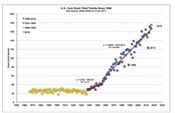|
Farm Productivity On The Upswing, But Is It Enough To Keep Pace?
SARA WYANT
WASHINGTON, D.C.
One of our favorite things to do this time of year is to drive across the country to visit farms and families across the nation’s mid-section. In a little over a week, my husband and I crossed over parts of Missouri, Nebraska, South Dakota, North Dakota, Iowa, Wisconsin and Illinois watching tractors and combines roll.
It’s usually a mixed bag or field conditions, depending on how the weather treated farmers in each state. We saw fields that were too soggy to harvest with at least one tractor stuck in a field, drought-stressed corn, and some soybean fields overtaken by weeds.
But for many other farms, there were record yields and an abundance of production. Corn is already piling up in huge orange mountains along Highway 12 east of Aberdeen and throughout much of Iowa.
Indeed, corn grain yields have steadily increased in the U.S. since the late 1930's, thanks to double-cross hybrid corn in the late 1930’s, adoption of nitrogen fertilizer and mechanization in the mid-50’s and continued genetic improvements. Since 1955, corn grain yields in the U.S. have increased at a fairly constant 1.9 bushels per acre per year, sustained primarily by continued improvements in genetics and crop production technologies, according to Purdue Agronomist Rob Nielson, who produced the chart.
That’s the good news. The sobering news is that, to support the ever-burgeoning world population in the years to come – an estimated 10 billion by 2050 – a third and major shift in the annual rate of yield gain will be required, noted Nielsen in a report earlier this year.
His assessment meshes with the Global Harvest Initiative’s (GHI) eighth annual Global Agricultural Productivity Report (GAP report), released to a packed audience of public and private industry leaders attending the World Food Prize last week. It's the fourth straight year that total factor productivity (TFP) lagged behind need, according to the report.
Keep in mind that TFP looks beyond just how much we are producing to measure the ratio of agricultural outputs, like crop and livestock output, to inputs, like land, fertilizer, feed and machinery. As a result, it enables policymakers to see how efficiently resources are being used and how well we are conserving resources to meet future needs.
Global agricultural productivity must increase by 1.75 percent annually to meet the global demands, but GHI’s GAP index shows the current rate of growth is only 1.66 percent, explained Margaret Zeigler, executive director of GHI.
That’s a result of TFP slowing in both high and low-income countries.
For low-income countries, the rate of agricultural productivity growth is only 1.24 percent annually.
“If agricultural productivity growth continues to stagnate, there will be significant ramifications for the economic vitality and environmental sustainability of food and agricultural systems,” Zeigler said. “The availability of affordable, safe and nutritious food will be undermined.”
“We are very troubled that the decline is continuing, particularly for the low-income countries,” said Zeigler. “For the fourth straight year, the low-income countries’ productivity is declining for the region of Africa.” And that could lead to “opening up new land in areas that are not really sustainable production areas, like tropical rain forests,” Zeigler added.
Panelists presenting the report noted that farmers are key drivers of agricultural productivity, but they face several challenges including volatile markets, shifting consumer demands, extreme weather, uncertainly over regulations and a mixed outlook for export opportunities.
“We must prioritize public and private agricultural research and development and improvements to regulatory systems to stimulate innovations that improve productivity and reduce costs for farmers,” said Doyle Karr, director of biotechnology at DuPont and chair of GHI’s board of directors.
The report notes that, even in high-income countries, new technologies like pest-resistant, high-yielding seeds, precision agriculture and improved animal care will enable farmers to increase output while controlling costs and resources.
Zeigler also focused on the importance of research.
“We know there are a few key things that will help with productivity, including investing in public agricultural research and development,” she told Agri-Pulse in an interview. "Investments in public research and development have really been stagnant for the last 10 years. We’d like people to talk to their policymakers and advocate in the next farm bill for an increased investment in the research and development."
In addition, Zeigler said that “conservation matters and we want to make sure that conservation investments are increased” in the next farm bill.
Overall, she hopes that people look at the report and learn more about how farmers face and surmount these productivity challenges, enabling consumers to understand the unique challenges face, as well.
To view the entire GAP report, http://www.globalharvestinitiative.org/gap-report-gap-index/2017-gap-report/ ∆
SARA WYANT: Editor of Agri-Pulse, a weekly e-newsletter covering farm and rural policy. To contact her, go to: http://www.agri-pulse.com/

|
|